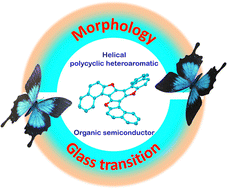The development of heat-resistant (opto)electronic devices requires semiconducting materials capable of forming compact and stable thin films. However, achieving this goal presents a formidable challenge for solution-processable organic semiconductors possessing superior thermomechanical properties. In this article, we have discovered the pivotal role of selecting the helical rather than planar isomers of tribenzotriazatruxene as the conjugated core in designing solution-processable organic semiconductors characterized by remarkably high glass transition temperatures, approaching 250 °C. Microscopic analyses have proved that organic semiconductors with a nonplanar helicene core can be solution-processed into morphologically uniform and integral thin films on various substrates, owing to a markedly improved solubility over 200 mg mL−1. Moreover, a combination of experimental measurements and theoretical modeling has revealed that the helical tribenzotriazatruxene-based organic semiconductor showcases superior hole conduction and water resistance attributes owing to the heightened molecular packing density. The unusual integration of these desirable properties into one material enables the fabrication of n–i–p type perovskite solar cells achieving an initial average power conversion efficiency of ∼24%, while demonstrating excellent operational stability and long-term thermostability at 85 °C.

